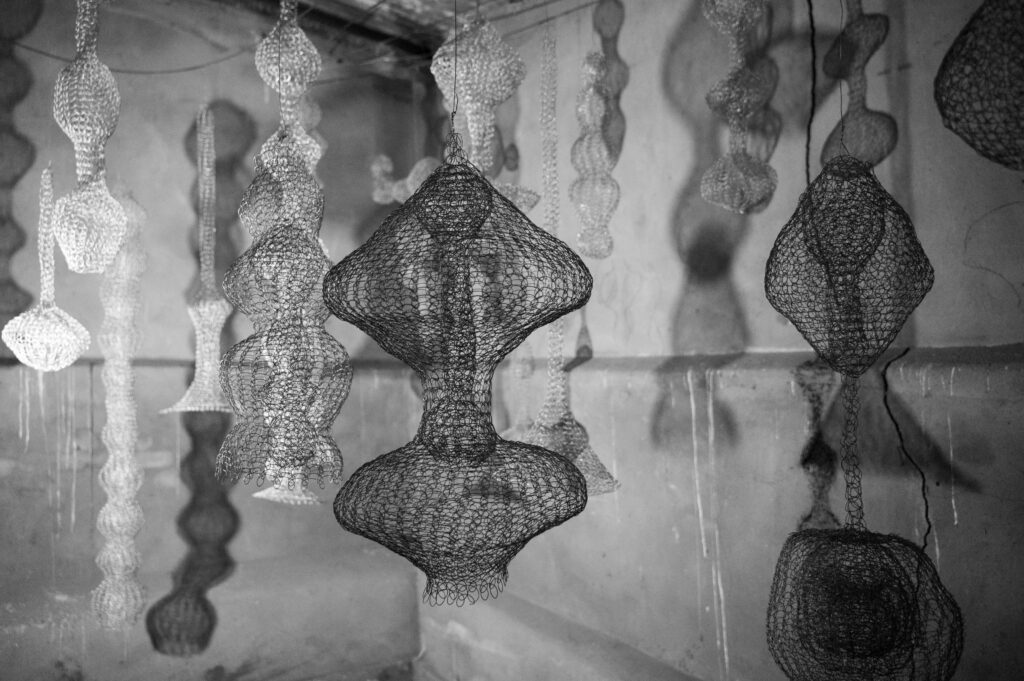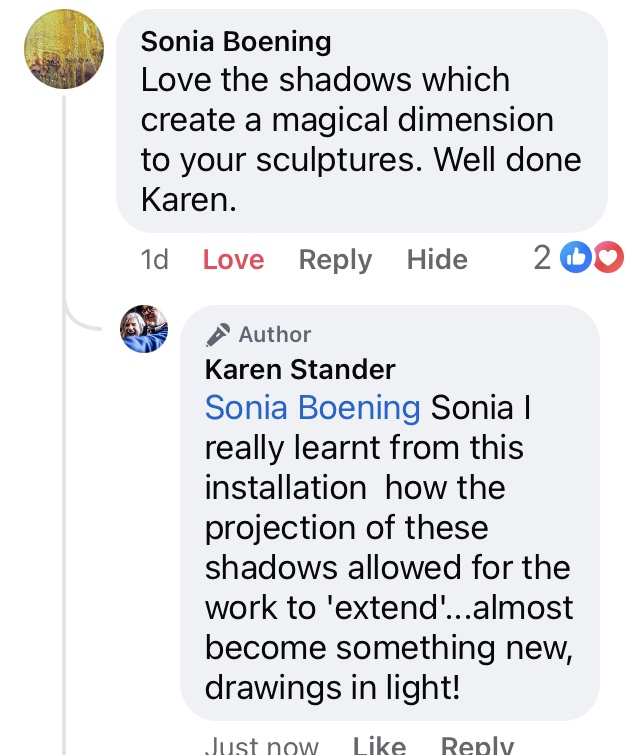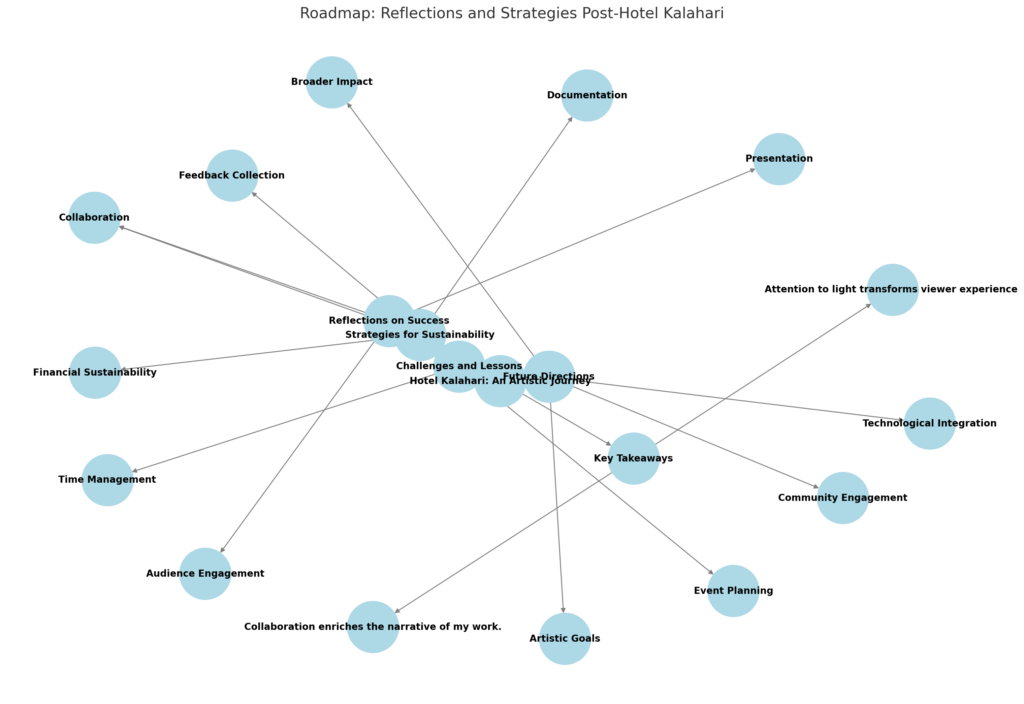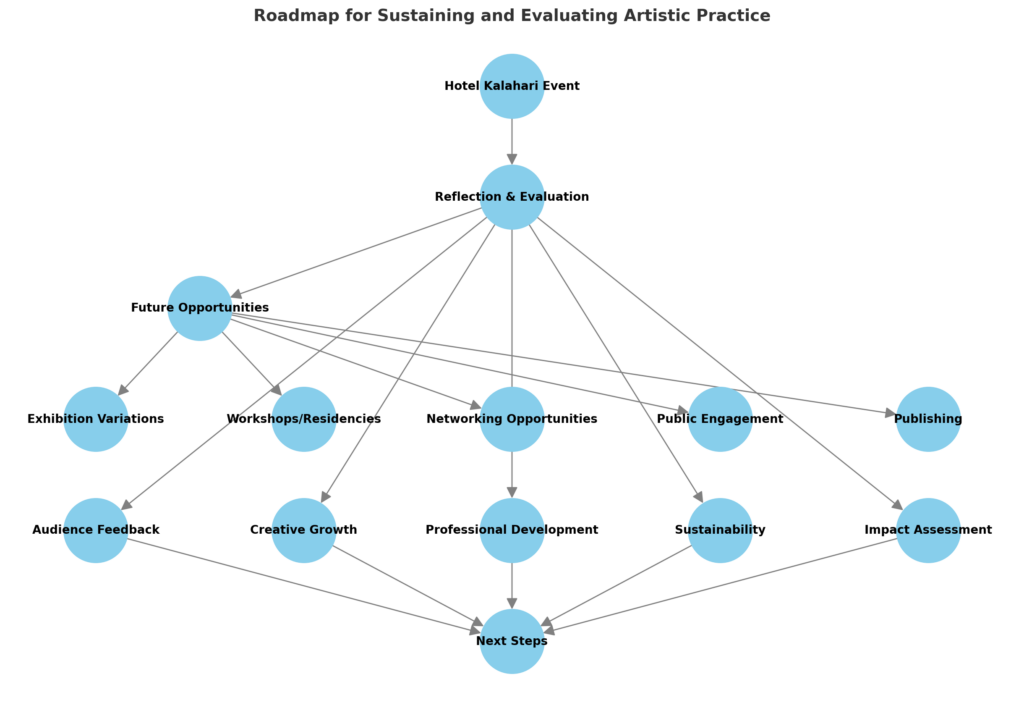As a reminder, my Project Plan maps out the process I decided to take to reach a public presentation of my work. I will consider that the following exercises also look beyond the scope of sustaining my practice after study.
In the notes I also reflect on: In this final part it will be important for you to reflect on the role of recording, and documenting as a significant professional and externally focussed activity. For example if you haven’t already, you might now need to consider how the documentation of your making and the work might be vital elements in successfully applying for future opportunities, such as residencies, exhibitions, funding, career development, training or postgraduate courses. Ergo the recording may be a documentation of the work, and yet purposeful in other ways, such as capturing or presenting a narrative of the process, site and/or collaborators in the making process.
EXERCISE: Reflect On and Evaluate your Practice Plan, your Process and your Progress
I enjoy critically reflecting on the Practice Plan (from now on, PP) regarding its fitness for purpose. Upon re-reading it, I have to consider whether it provided me with a sound road map to move forward, build my practice, and achieve my goals.
The main stages and stepping stones for the PP were:
- deciding on the body of work and preparing it,
- staying truthful to my artist statement
- focus on the material,
- anticipating what skills I needed to acquire (in my case, I also had to learn about lighting the exhibition area, hanging the work – using the correct materials, marketing on social media and designing marketing materials sensitive to the body of work, working with a plan to execute, re-focus and evaluate.
- extending my research through the work of other artists and
- field trips to ensure a contextual basis for the work and use the knowledge and guidance of others,
- collaboration and feedback from peers,
- Inviting viewers to engage with your work—by sitting down to look and to listening to the sounds of the weavers—breaks the traditional distance between art and audience.
- making connections and growing networks.
- I also had to consider documentation and the use of video and still photos—the learning blog is sufficient, but I also worked on my website to have a separate section showing the PP.
- Researching and reading about marketing an exhibition, choosing a venue, and considering health and safety issues.
- Managing timelines was one of the main stages of achieving my goal of presenting my wirework as a coherent body of work to the public.
- In terms of time, this was during early September, after I completed Part Three of the course. I considered the course duration and wanted my final assessment date to be January 2025. My tutor agreed this was doable, and I knew I needed to keep my momentum with the work.
- During Part Four of the course, I was sure that the venue would be on the farm where I live, and I had the opportunity to find a suitable space other than a white cube for my work.
- My main goal was to present my wirework as a coherent body of work to the public. I started promoting the exhibition once I had my space, funding/budget, and timeline.
- Never underestimate the value of family and friends – grow your support group from here
- I look back at the opening event as an intimate experience and that I had the opportunity to build my reputation in this village.
I want to evaluate what I learned from researching, making, and testing my practice plan and progress.
The notes refer to:
- Which specific learning experiences do you recognise as most valuable for developing plans?
- How might you utilise these to sustain your current and future practice?
Looking back on the exhibition I call my major project, I can see that the experience started with researching the material and techniques for making. I mastered learning to e-loop with wire and studying other artists to develop my ideas around size, form, and scale and to ensure the quality of the work. Over time, my skills have improved, and by now, I could focus on the wire work I wanted to include in the exhibition. Sharing my work regularly with peers helped me stay motivated to create different work and consider its size and scale. I look back and know I never lacked motivation to continue – I was so into this process. I am glad I followed my tutor’s advice to focus on the wire work. Parts Three and Four of the course taught the practical side of curating, exhibiting and presenting the work.
I had time to research the process of Asawa more, which helped me learn how to improve my work – like working with the same wire but using different sizes of e-loops in one work. “Though Untitled (S.077) demonstrates Asawa’s technical ability to work with continuous wire; in the majority of her sculptures, she prioritised the perception of weightlessness by combining different wire gauges to form the appearance of a continuous surface.[37] In her complex, multi-lobed sculptures, she often created the smaller, interior forms using the narrowest gauge of wire, and she used progressively thicker gauges to form the outer layers. Asawa’s structure concealed the breaks and joins between her different strands of wire. The effect of using multiple wire strands to create a unified surface gives her sculptures the structure and appearance of total continuity..” Courtauld website: https://courtauld.ac.uk/research/research-resources/publications/immeditations-postgraduate-journal/immediations-online/immediations-no-18-2021/the-immateriality-of-materiality-ruth-asawas-looped-wire-sculpture/
I worked in one ‘gauge’ and switched to thicker gauges when working on a more significant object’s outer layers. I realised my work does not have a unified surface, and this method will enhance its appearance.
My most significant learning in refining, adapting and resolving was using shadow and light in the wire work, especially the objects that developed alongside the nest. when hung or exhibited, the shadow effect adds to the sculptural narrative, giving the form a secondary representation. I looked at the optical phenomenon known as the transmission or projection of shadows. The shadows on the walls around the sculptures hanging are almost drawings of the sculptures. This also sets the scene for a story about the work, where one could weave in ideas of resilience and connectedness.

This phenomenon is known as the transmission or projection of shadow. Here, light is reflected and directed through the open spaces between the wire loops, casting a shadow on the surface behind it. These shadows are almost “drawings” of the wire structure, like a secondary representation of the sculpture. They produce a visual echo, which can appear as an entirely new dimension of the form, giving the work a multifaceted presence.
This shadow effect also adds to the sculptural narrative. It makes the form dynamic—its structure is not limited to the physical object. Still, it extends into its shadow, implying that the relationships and connections represented by the loops of wire also reach outward, resonating beyond their boundaries. This idea of creating new forms through shadow emphasizes the themes of resilience and interconnection, showing how the “essence” of the nest—its emotional and symbolic weight—reaches out into the space, inviting viewers to contemplate the invisible threads of connection in their lives.
Below is a discussion on Instagram, in which I now see positive feedback that I could resolve and achieve what I set out to do:

By making the enormous sociable weaver nest, I learned that my practice is informed by animal /human studies research and that I am interested in the ecology that plays out during this process. Something happened during ‘field visits’ – I was being informed by the thing – the nest itself. I observed the texture of the nest, the spikes of the grass used to build the nests, and the birds coming and going to and from the nest. BUT: I did not take a scientific approach to making and choosing materials. I did not want to represent nature realistically – nature taught me to watch, see, listen and learn. I did, for a moment, have the chance to explore something of a human/nature interface. I contacted ecology experts and secured an informed speaker for the opening event using this connection. This added to enhance the visitor experience and understanding of the work, together with my talk.
Exercise 2: ROAD MAP/ DIAGRAM
Having a plan and managing this process can be seen as a roadmap for looking at future events and considering how I might use them to sustain my current and future practice. Below is a roadmap, where each node represents a key area of focus, such as successes, challenges, strategies, and future directions, while the connections highlight their interrelations.

I wanted to focus more on future projects and how I could use the experience and a roadmap to identify key phases and components, such as:
Reflection & Evaluation: Reflecting on the event’s outcomes and gathering feedback.
Future Opportunities: Exploring variations, workshops, residencies, networking, and publishing.
Audience Feedback: Incorporating insights from your audience. Use the idea of sharing an anonymous question/feedback
Creative Growth: Leveraging insights to inspire new directions. Here I am thinking about building upon my existing practice by incorporating new materials, such as combining wire with organic or found objects to explore themes of fragility and permanence. I can also explore interdisciplinary approaches—e.g., merging my wire art with digital projections, soundscapes, performance work or collaborative writing. I also think there is scope to experiment with scale, creating more intimate works and larger installations that interact differently with space. Regarding conceptual themes, I would like to delve deeper into the metaphor of nests as places of resilience and impermanence, linking it to broader global themes like migration, war, climate change, or community. In terms of local community, I can engage with communities to incorporate collective experiences or participatory elements into my work.
Professional Development: Expanding technical and visual skills and industry knowledge. Keep in contact with professionals and professional bodies. Identify long-term creative goals, like experimenting with public art, exploring site-specific installations, or expanding into new mediums.
Sustainability: Ensuring long-term relevance and impact. I wrote a blog about the fact that I feel there is much I want to explore, as nature is fascinating and gives me so much ‘material’ to work with. I want to continue exploring collaborative opportunities in my local community and with artist connections in the rest of the world. Here, my current connection and newly formed collaborative partners will be valuable. I like the possibilities of cross-disciplinary collaboration – my study of nests has opened these opportunities up. I also value that the aesthetics of the commons value process and participation over polished outcomes. Considering aesthetics in my work, my wire nest which could be ‘worked on’ by others and the barn as a space where the installation interacts with its environment – the farm, the animals, the light, etc. Concerning ideas around ownership, I am comfortable that, for example, the barn could become a recurring venue for other artists, fostering a shared resource. Ideas of distributing authorship will reinforce interconnectedness, which is central to my practice – all contributors (spaces, individuals, materials) will be seen as co-authors of the work. I foresee that the idea might be challenging to sell to galleries, who prefer individual or commodified art. It also challenges ownership. In terms of the collaboration group, I would think the biggest threat to manage would be how we address power dynamics, inequities, or conflicts within.
Impact Assessment: Measuring the event’s success and reach.
Next Steps: Consolidating all insights into actionable future strategies.
Below is a roadmap where I use opportunity nodes (collaboration, publication, etc.), evaluation nodes (audience feedback, professional growth, conceptual development), and integration arrows to indicate how past experience informs future goals and how progress feeds back into creative growth.

Considering the Research Task: IS MY PROJECT READY?
After discussing whether one is ever ready after the tutorial on Part Four, I conclude: Ultimately, readiness for an exhibition isn’t about perfection but confidence in your work and its ability to engage meaningfully with an audience. Recognizing that art is constantly evolving, exhibiting can also serve as a point of reflection and dialogue for future growth.
Evaluating the role recording and documentation play in my work and how I could make this process more relevant, purposeful, or dynamic is essential. I am uncomfortable with a camera in hand or in front of a camera. I prefer to write during my making and visualise a story with images. I want to continue using documenting as an art practice. I see my creative journey as part of the art, so I document my experiments, thoughts, and iterations. I will use this documentation for future exhibitions, workshops, or publications. In my first notes on making the nest, I added details about size and weight and estimated how much material I used. This helped me assess the time of the exhibition.
Ideas on the sociable weavers as ecological engineers in how their nests are being constructed, specifically in creating a microclimate for the birds, their eggs and offspring, was great learning. I think about this social structure where cooperative behaviours and survival strategies allow the group to thrive in a challenging ecosystem. This sparked an interest in ecology and how we should learn from experience to deal with our environment. Here, I see how birds use tools to solve their problems, and I use my art to react to this. In embodying these lessons through art, I can bring a message of ecological mindfulness and resilience. My work can illustrate that, just as birds create tools and structures that enhance survival, we too can build—responses to our environmental and social challenges. Integrating my interest in cooperative behaviours and ecological intelligence, my art becomes a statement on learning from nature’s sustainable strategies and a call for deeper environmental engagement. I have placed all this ‘research information’ in a separate blog post:
Monetary value and market ideas: I had to open up to placing a monetary value on my work when interacting with viewers. I was unprepared for this during the exhibition, mainly because of my fear of rejection. I have since plucked up the courage to talk to a local curator and other artists who have been around for a long while and are willing to discuss how I should price my work.
I learned a lesson from sharing my work with the public: how my art made people feel. I received so much feedback that people thought they had a connection with the work. This is important because it should be a reason to buy art. I asked my peer group if they would like to answer my question.
I received this feedback on WhatsApp: “It is a great question and one I’m interested to talk about. In my little experience so far it has been a combination of both, but definitely started with them, their feelings, their needs, their time in in their life. What my intention was came second, even though there was still interest in it.”
In these discussions, we also talked about ‘real’ art and ‘decorative’ art, but we, as makers, do not decide which is which. Our job is to make whatever we feel like. I discussed this with fellow students and ‘real’ working artists I could trust. As I was discussing this, I came to a point where I had to ask myself what my fear was – letting go, letting go of what?
Bernadette Jiwa says, “People don’t buy why you do something. T hey buy how it makes them feel.” If you think about it, this, ironically, leads to your Why: Connection.
But it is also a reality that one has to take experience into account – I also think one has to be ‘known’ by the market. This takes time and effort in terms of my future marketing strategy.
Below is research I have looked at, which confirms the ideas. (Ecological engineering across a spatial gradient: Sociable Weaver colonies facilitate animal associations with increasing environmental harshness)
Artists research and consider new materials or extend the current method
I have been researching the works of Anna Hepler recently. She works with ceramic, wood, metal, and paper, both hand-held and on a monumental scale. I learned that her work grows out of experience, so she lets each new piece be informed by the last. Hepler coordinates a series of mutations that turn a collage into a woodcut, a woodcut into a print, a carved woodblock into a sculpture, and a wooden sculpture into a clay form. She portrays folded, slumped, stacked or intertwined forms in which one material looks or behaves like another. Wood slats mimic hanging rope; woodblocks resemble animal hides; drypoint etchings simulate cloth scraps; ceramics are steel; and wire sculptures drape and flow like fabric. Hardwired presents recent work from Hepler’s exploration into the language of visual perception, its illusions, its grammar of depth, surface, and edge, and the impressions gathered when certainty is lost. I started collecting cardboard to create a nest with rolled/folded cardboard.